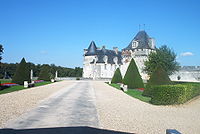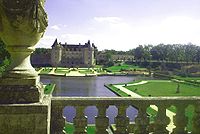
Château de la Rochecourbon
Encyclopedia

Charente-Maritime
Charente-Maritime is a department on the west coast of France named after the Charente River.- History :Previously a part of Saintonge, Charente-Inférieure was one of the 83 original departments created during the French Revolution on 4 March 1790...
département of France
France
The French Republic , The French Republic , The French Republic , (commonly known as France , is a unitary semi-presidential republic in Western Europe with several overseas territories and islands located on other continents and in the Indian, Pacific, and Atlantic oceans. Metropolitan France...
. It is in Saint-Porchaire
Saint-Porchaire
Saint-Porchaire is a commune in the Charente-Maritime department in southwestern France.-Population:-References:*...
between Saintes
Saintes
Saintes is a French commune located in Poitou-Charentes, in the southwestern Charente-Maritime department of which it is a sub-prefecture. Its inhabitants are called Saintaises and Saintais....
and Rochefort
Rochefort, Charente-Maritime
Rochefort is a commune in southwestern France, a port on the Charente estuary. It is a sub-prefecture of the Charente-Maritime department.-History:...
. Its name is just as frequently written Château de la Roche Courbon.
Built in the 15th Century, upon a rocky outcrop in the midst of marshland, the original castle was transformed into an elegant residence by Jean-Louis de Courbon, during the 17th Century. As the marquis would not flee during the French Revolution
French Revolution
The French Revolution , sometimes distinguished as the 'Great French Revolution' , was a period of radical social and political upheaval in France and Europe. The absolute monarchy that had ruled France for centuries collapsed in three years...
, the château was not sold. His daughter Charlotte married an aide de camp of Napoleon. Because upkeep was so expensive, however, the château became abandoned during the following hundred years.


From the Renaissance terrace, a two-stage staircase leads to the splendid French gardens with a series of terraces and balustrades. The gardens include orchard, flower garden, geometrical flower beds and lawns surrounding a small lake ('mirror pool'). The River Bruant flows through the gardens, feeding the water features. Beyond that, an ornamental staircase leads to higher ground, on the far side of the river. In the 'keep' is a museum containing prehistoric objects.
In the grounds are some stone age
Stone Age
The Stone Age is a broad prehistoric period, lasting about 2.5 million years , during which humans and their predecessor species in the genus Homo, as well as the earlier partly contemporary genera Australopithecus and Paranthropus, widely used exclusively stone as their hard material in the...
cave dwellings, at the base of sandstone
Sandstone
Sandstone is a sedimentary rock composed mainly of sand-sized minerals or rock grains.Most sandstone is composed of quartz and/or feldspar because these are the most common minerals in the Earth's crust. Like sand, sandstone may be any colour, but the most common colours are tan, brown, yellow,...
cliffs, in woodland close by the river Bruant. Prehistoric finds from the site are housed in the 'keep'.
Pierre Loti
Pierre Loti
Pierre Loti was a French novelist and naval officer.-Biography:Loti's education began in his birthplace, Rochefort, Charente-Maritime. At the age of seventeen he entered the naval school in Brest and studied at Le Borda. He gradually rose in his profession, attaining the rank of captain in 1906...
(1850–1923) spent holidays with his sister in the Saintonge
Saintonge
Saintonge is a small region on the Atlantic coast of France within the département Charente-Maritime, west and south of Charente in the administrative region of Poitou-Charentes....
region. On his excursions, he (re)discovered the Château de la Rochecourbon, in an abandoned and ruined state, overgrown with brushwood. Benefiting from his fame, Pierre Loti brought the château to notice by calling it the "sleeping beauty of the forest" and launched a public appeal to save it and its forest.
Paul Chénereau (1869–1967), a local man, bought the château and restored it to its former splendour. It is actually his daughter and son-in-law, who now live there.
Today, the Château de la Rochecourbon is open to visitors and is a favourite among marrying couples, for wedding photographs.

